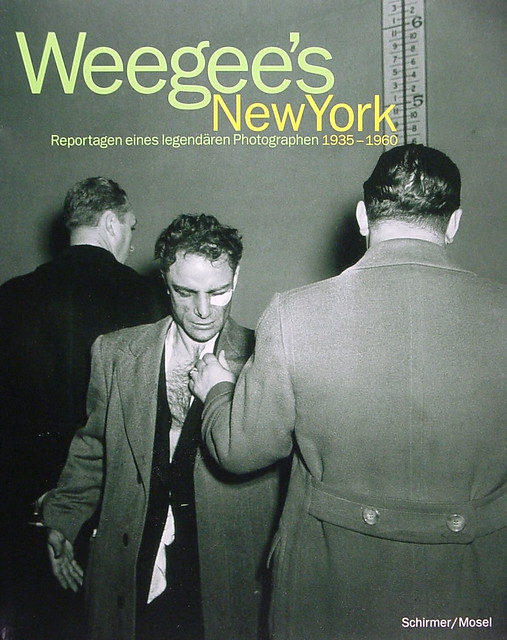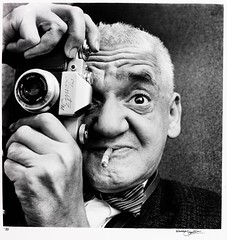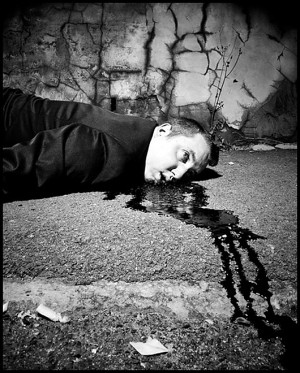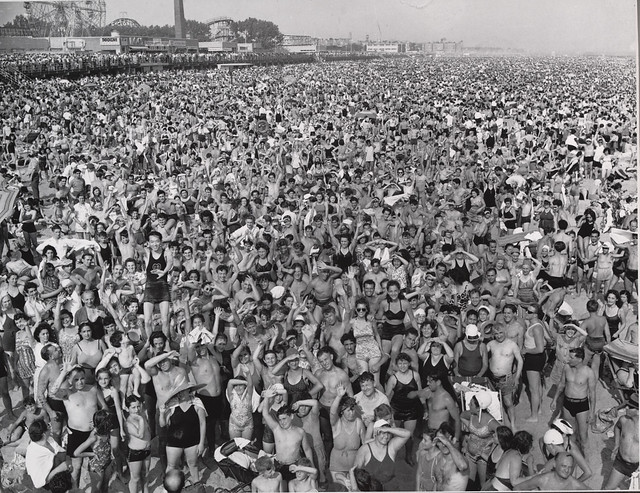
![]() BY MIKE WALSH If you enjoy Weegee’s famous crime and disaster scene photos from the 1930s and 1940s (as who doesn’t?), get yourself to the International Center of Photography (ICP) in Manhattan where Murder is My Business, an exhibition of Weegee’s most famous photos recently opened. Weegee’s photos are fun, trashy, insensitive, and full of suffering and blood. What’s not to like?
BY MIKE WALSH If you enjoy Weegee’s famous crime and disaster scene photos from the 1930s and 1940s (as who doesn’t?), get yourself to the International Center of Photography (ICP) in Manhattan where Murder is My Business, an exhibition of Weegee’s most famous photos recently opened. Weegee’s photos are fun, trashy, insensitive, and full of suffering and blood. What’s not to like?
The great thing about this exhibition is that it includes wall plaques of information about the specific car crashes, tenement fires, suicide, and gangland murders depicted in the photos. It does not leave you speculating about why the people pictured at the scene of these lurid scenes are behaving in such strange ways.
The exhibit also includes police photos of the same scenes along side Weegee’s photos, so you can compare a plain, utilitarian photo with one composed by Weegee. This comparison shows that Weegee almost always included spectator reaction. In fact, many shots in the exhibit are nothing but crowd reaction, either spectators in shock, amused, goofing off, or crumbling emotionally from the loss of a loved one. Weegee’s photos of fires were almost never of the actual fire, but usually of people emerging from the burning building or watching the building burn. His ability to incorporate the human impact of tragedies into his photos at least partially explains Weegee’s success. It puts the viewer at the scene. The emotion is more immediate.
Many displays in Murder is My Business also contain actual newspaper or magazine spreads in which Weegee’s photos appeared. So you get  not only the museum perspective of a raw Weegee print, but you see how his dramatic, lurid photos were presented to the public. The photos frequently appeared above the fold on the front page with a screaming headline and a caption reeking of indignation at the moral turpitude of Gotham’s citizenry.
not only the museum perspective of a raw Weegee print, but you see how his dramatic, lurid photos were presented to the public. The photos frequently appeared above the fold on the front page with a screaming headline and a caption reeking of indignation at the moral turpitude of Gotham’s citizenry.
During those most famous and productive years of Weegee’s long career, he lived in a Spartan room next to a police station, and that famous room is partially recreated in the exhibit. When Weegee would hear reports of a shooting or fire, he would hi-tail it in his car to the scene, usually arriving within minutes and often before other press and the police.
Amazingly, he had photo processing gear setup in the trunk of his Chevy, so he would shoot the scene, print photos, and sell them to reporters from other newspapers and magazines within minutes. One photo in the exhibit shows him sitting at the open trunk of his car at the scene of a disaster typing copy to appear with one of his sensationalistic photos. Another shows Weegee proudly displaying a check stub from Life magazine for $35 for photos from two murder scenes. The one with the bullets earned him slightly more, he explained at the time.
Weegee, whose real name was Arthur Fellig, grew up in a poor immigrant family, so he knew the value of a dollar and learned to hustle at an early age. One of his first jobs was as a photo developer. He soon took up photography, and realized that he could earn a living taking photos of car crashes, mob hits, fires, drownings, etc.
With just the right set of skills, proximity to urban violence, a portable police-band shortwave radio, a willingness to hustle, and no sensitivity for the privacy or misfortune of others, Weegee became the country’s first freelance photographer, even though he had no formal training in photography. Such a profession did not exist before Weegee. No disaster was too bloody or the suffering too great or too private for Weegee’s camera. We can assume the subjects front and center in his photos weren’t asked to sign releases and weren’t given royalties either.
 He also became an expert at self-promotion, and the exhibit shows many of his staged self-portraits–Weegee at a crime scene with the corpse, Weegee examining evidence in a police station, Weegee interviewing a suspect, and even Weegee behind bars. He signed many of his photos “Weegee the Famous.”
He also became an expert at self-promotion, and the exhibit shows many of his staged self-portraits–Weegee at a crime scene with the corpse, Weegee examining evidence in a police station, Weegee interviewing a suspect, and even Weegee behind bars. He signed many of his photos “Weegee the Famous.”
The exhibition also recreates Weegee’s first public exhibit of his photography in New York in 1941, also titled Murder is My Business. A photo shows Weegee preparing for the exhibit by painting red fingernail polish on a black and white photo, so no one would miss the blood.
Weegee credited much of his good fortune to Murder Inc., a nickname given to the hit men who gunned down thousands of people in the tough New York City neighborhoods during those years. He claimed to have photographed over 5,000 murder victims, referred to himself as the “official photographer of Murder Inc.,” and was friendly with mobsters like Bugsy Siegel, Lucky Luciano, and Legs Diamond.
Weegee usually worked at night and most of his shots were taken with a flash, which produced flat, harsh photos, a style that became synonymous with Weegee and tabloid photography. These are not photos of detail or subtlety; they are of raw emotion and loss, which the style heightens.
And if that’s not enough Weegee for you, head to the Steven Kasher Gallery in Chelsea (521 W. 23rd St.). Naked City displays another hundred of so examples of Weegee’s photography and shows that Weegee was about more than urban violence and mayhem. It includes photos of celebrities at night clubs, partygoers, young women swooning at a Frank Sinatra concert, a midget in a diaper at a bar, hefty cabaret performers laughing, and more. Weegee captured Manhattan at night in the 30s and 40s like no other.
Naked City at Steven Kasher Gallery runs until Feb. 25. Murder is My Business at the International Center for Photography runs until Sept. 2. The entry fee is $12.
[Click to enlarge]

